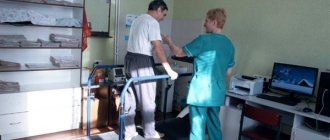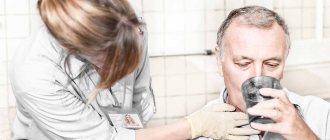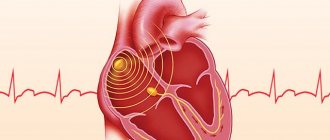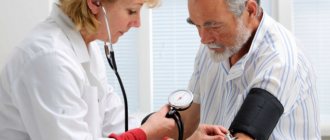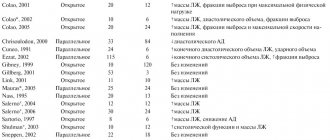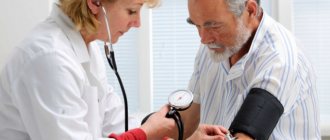From this article you will learn:
- What are the features of a heart attack in old age?
- What tasks does rehabilitation set for itself?
- How long does it take for people who have had a heart attack to recover?
- How is the rehabilitation of elderly people after a heart attack carried out step by step?
- What to change in life to prevent a relapse
One of the main public health problems is myocardial infarction in the elderly. Half of patients aged 70 years and older die from this disease, and after 80 years this figure increases significantly. It is age that is a risk factor in the post-infarction period for those over 75 years old - in the first month the probability of death in this category of patients is four times higher. For this reason, rehabilitation of an elderly person after a heart attack must be very competent and carried out in the best conditions.
Features of heart attack in old age
Older people tend to suffer from serious illnesses. A heart attack is no exception, but do not despair. Even if it happened, there is a good chance of a successful outcome. But you should know what the main features of the course of the disease in older people are:
- the presence of angina over a long period;
- risk of small-focal heart attacks;
- arterial hypertension;
- no pain;
- hidden nature of the pathology, symptoms similar to thoracic radiculitis;
- the course of the disease simultaneously with cerebrovascular insufficiency;
- the risk of cardiogenic shock, which in 90% of cases ends in death;
- diabetes;
- relapses.
It is almost impossible to diagnose a heart attack at an early stage, so doctors recommend being thoroughly examined every year for risks.
Modern medicine has sufficient screening capabilities. You should not neglect them and undergo medical examinations in a timely manner.
Angiography procedure
During medical imaging, the doctor observes the condition of the blood vessels. During the procedure, a dye is injected into the circulatory system, which highlights narrowed areas and areas of blockage in the coronary arteries during X-ray diagnostics. Computed tomography and magnetic resonance imaging are used for the same purpose.
A blood test can detect heart muscle proteins of type I or T troponin 360 minutes after myocardial infarction. This study actually confirms the diagnosis already made. However, you should not delay the tests, since lost time with this diagnosis will work against the patient.
Carrying out an echocardiogram
This diagnostic method is similar to an ECG. It determines the degree of damage to the heart during a heart attack.
Treadmill stress test
While running, the patient's ECG is recorded.
Important ! Even some regularly performed cardiac examinations, for example, angiography, do not completely identify the risk of a heart attack or heart problems, especially in females. The symptoms of the disease in older people are not typical. 40% of patients do not feel any pain. If there is pain, it is much less intense than in young people. In addition, the pain is often localized in different places (back, abdomen, shoulder).
It happens that signs of a heart attack can include neurological symptoms (confusion), gastrointestinal disorders (belching), and nonspecific phenomena (general weakness).
Causes of the disease
The cause of an extensive heart attack is thrombosis, which usually develops as a complication of atherosclerosis - the formation of an atherosclerotic plaque on the wall of a vessel.
When such a formation reaches a large size, it can rupture or become damaged, which provokes the formation of a blood clot. The thrombus clogs the lumen of the vessel, and the heart muscle cells stop receiving oxygen. This provokes the death of myocardial elements. The larger the area nourished by the clogged vessel, the more cells will die. If the patient is taken to the hospital quickly, doctors are able to remove the clot and reduce the area of necrosis.
Indirect causes of a large heart attack are called risk factors. They themselves do not cause AMI, but increase the likelihood of developing pathology. These include:
- older age;
- male gender;
- hereditary predisposition;
- violation of fat metabolism;
- arterial hypertension;
- obesity;
- diabetes;
- poor nutrition;
- passive lifestyle;
- smoking;
- alcohol abuse.
Objectives of rehabilitation of the elderly after a heart attack
As a result of impaired blood supply to the body, tissue necrosis occurs - a pathological condition called infarction. Many people are often mistaken in thinking that the disease can only affect the heart. Other tissues and organs are also susceptible to it.
However, the most common and life-threatening is myocardial infarction, that is, damage to the muscle tissue of the heart.
Medical classification divides myocardial infarction into two types: small-focal and large-focal. The first type is a fairly mild form, while the second is characterized by a rather severe condition in which the ability to work can be completely lost. In all cases, immediate intervention (medical or surgical), hospital treatment and further long-term rehabilitation are required.
In order for an elderly patient to recover and return to a full life, a course of recovery is necessary, which plays a key role. During rehabilitation measures, the diet and diet, as well as the entire lifestyle of the heart attack victim, change. Elderly patients should eliminate bad habits and engage in physical therapy.
Activities within the framework of rehabilitation significantly prolong life and also reduce the likelihood of new attacks.
Thanks to restorative procedures, there is every chance to avoid disability and disorders of physical and mental activity.
Objectives of the rehabilitation period:
- Normalization of the cardiovascular system, adjusting heart rhythm, controlling blood pressure with the help of medications and lifestyle changes.
- Stabilization of the biochemical composition of the blood, in particular, reducing the content of bad cholesterol. Improving the performance of the heart muscle by increasing physical endurance.
- Restoration of the patient’s capacity, who is gradually prepared to comply with the work schedule, that is, for mental and physical stress.
- Relieving psychological stress, which leads to disruptions in the functioning of the heart, by smoothing out emotional experiences.
- Stress resistance training in order to prevent possible relapses and maintain the performance of the whole organism.
After the end of the crisis, a recovery period begins, during which doctors carry out rehabilitation measures to preserve the elderly patient’s health and physical abilities.
Angioplasty and coronary artery stenting
One of the effective and widespread methods of treating acute myocardial infarction throughout the world is coronary angioplasty with the possibility of installing a stent. The advantage of the operation is that it is extremely minimally traumatic: a small puncture is sufficient to insert a catheter into a peripheral vessel (usually the femoral artery serves as a transport vessel). The goal of high-precision manipulation is to widen the coronary artery in the place where it is blocked.
The catheter, under the control of X-ray equipment, is passed through the vascular system to the site of narrowing of the coronary artery. At the end of the catheter there is a miniature balloon, which is in a compressed state. An X-ray contrast agent is injected into the vessels, and the doctor has the opportunity to observe the manipulations on monitors in the operating room. The cardiac surgeon places a balloon in the affected area of the vessel and inflates it with special equipment, thereby restoring blood flow.
To prevent the walls of the artery from narrowing again, a cylindrical stent is inserted into it in the same way and secured. Thus, it replaces the affected area of the vessel.
Terms of rehabilitation for elderly people after a heart attack
Each case of heart attack is individual in its manifestations. But there are several general patterns. The official classification divides the severity of the disease into 4 degrees. The first degree is quite mild and is characterized by small focal lesions without complications. The fourth, the most severe, is dangerous due to large areas of damage, aneurysm and other serious consequences.
The duration of the recovery period directly depends on the assigned severity level. For example, if necrosis after a heart attack occupies a small area, then the patient undergoes rehabilitation for six months. Whereas an extensive myocardial infarction leads to complications that are eliminated only after a year, or even more. All subsequent stages of rehabilitation proceed much more slowly. Severe patients begin to walk and exercise much later.
Recommended articles on this topic:
- How to support your heart in old age
- What vitamins and minerals are needed by the heart of an elderly person?
- Health in old age: how to care for an elderly relative
If we talk about older people, then due to age and, as a consequence, deterioration of the body as a whole, complications after such a blow occur in them much more often. It is this fact that is associated with a significant increase in the rehabilitation time for older people after a heart attack (up to two years, subject to good care and strict adherence to medical recommendations).
Symptoms, diagnosis of AMI
There are two types of symptoms of a major heart attack:
- typical;
- atypical.
Typical manifestations of AMI include:
- weakness;
- chest pain;
- shortness of breath;
- the pulse is usually rapid, but may be irregular;
- blood pressure may rise and then fall.
Some features distinguish chest pain in the pre-infarction state from attacks of ordinary angina:
- the pain is very intense, lasts 30-60 minutes;
- radiates to the neck, shoulder, jaw and scapula;
- does not go away after taking nitroglycerin tablets.
Atypical signs of the disease in their symptoms resemble other diseases: bronchial asthma, an attack of acute pancreatitis, stroke. Atypical pain is characterized by less severe chest pain.
Diagnosis of AMI involves instrumental examination:
- ECG;
- Ultrasound of the heart;
- determination of myocardial infarction markers in the blood (troponin, troponin-1, CPK, AST, LDH);
- general blood analysis;
- angiography of the coronary vessels.
Rehabilitation methods for older people after a heart attack
The rehabilitation period is divided into a number of important stages, including measures aimed at the complete restoration of the body after a heart attack. These measures include: taking medications, physical activity, diet, and lifestyle changes.
Drug rehabilitation
The initial action to stabilize the condition after a heart attack is medical intervention in the form of medications. It is necessary to immediately eliminate the pain symptom with the help of narcotic analgesics. Thrombolytics are necessary to dissolve blood clots. Further therapy in a hospital setting involves the use of direct and indirect anticoagulants, as well as beta blockers and ACE inhibitors. All these drugs reduce the load on the heart muscle and prevent the formation of blood clots.
We recommend
“How to strengthen the heart in old age” Read more
After treatment in a hospital, medications are prescribed depending on the severity of each individual case. The presence of concomitant diseases, the cause of blood clot formation, as well as the characteristics of the elderly patient’s body are taken into account. Therefore, during the further period of rehabilitation, the doctor may prescribe medications that reduce blood pressure, eliminate swelling, reduce blood clotting, and others.
It is especially important in the first few months after a heart attack to regularly monitor the condition of an elderly patient. This is necessary for timely prescription of medications in case of deterioration.
Physical rehabilitation after a heart attack
Already in the first days after an attack, attention must be paid to the rehabilitation of a person’s physical abilities. For this purpose, minor loads are prescribed in the hospital. Elderly patients begin to sit up, turn over in bed, wash their faces and brush their teeth on their own. When the damaged tissue has healed a little, the patient can perform simple gymnastic exercises, walk around the ward, and then along the corridors and stairs.
At home, physical activity can be gradually increased, walking more, performing complexes of therapeutic exercises and aerobics. To start, 15 minutes a day is enough, then every week add 5 minutes to this time, until you reach an hour. But the types and quantity of exercises performed are determined by the doctor, since there is a risk of getting not a positive, but a negative result.
We recommend
“A set of exercises for older people: body and breathing” Read more
Mental rehabilitation
During the first weeks, it is especially important to pay attention to the psychological state of the patient, as he is aware of the disease and its possible consequences, feels helpless and is very afraid of a second attack.
Changes occur in the patient's character at this time: he becomes overly irritable and sometimes aggressive. This situation requires the support of a psychologist who will help you accept what happened and explain that a heart attack is not a death sentence.
If an elderly person has a positive attitude and is in a favorable frame of mind, then rehabilitation will be much better and faster. Therefore, do not be afraid to turn to specialists for help.
Diet
A nutritious and balanced diet after a heart attack is necessary to restore the body and prevent further strokes.
In order for the heart to experience less stress, portions are reduced for an elderly patient in the first days after a myocardial infarction in the hospital. The diet includes soups, pureed unsalted food without adding spices. When the tissue begins to scar, the diet becomes more saturated, but salty and fried foods are still excluded from the diet.
In further rehabilitation, it is necessary to eat properly at all times. The usual diet should include fresh vegetables, fish and seafood, and lean meat. You need to eat in small portions. In addition, it is necessary to exclude unhealthy foods, fatty, salty foods, as well as sweets, sauces and spices.
We recommend
“Vitamins for the elderly: list of vital drugs” More details
The daily intake of liquid should not be more than 1–1.5 liters per day. If an older person is overweight, they need to lose it. But you shouldn’t go on a strict diet, you just need to reduce the calorie content of the food you eat.
Lifestyle
Bad habits are harmful to the body. In addition, they can provoke serious illnesses. People who have suffered a myocardial infarction need to change their entire lifestyle not only during the rehabilitation period, but also in the future. They should get plenty of rest, give up cigarettes and alcohol, and exercise regularly.
Coronary artery bypass grafting
It is also a very effective method of treating myocardial infarction. The purpose of this operation is to create a new path for the blood, bypassing the vessel affected by atherosclerosis. For this, a special shunt is used - a part of the patient’s own vessel, taken from the thoracic artery or radial artery of the arm. It is sewn into the narrowed or blocked artery above and below the site of the lesion. Thus, the volume of blood required for heart function is normalized. Doctors are able to restore blood circulation in the affected area of the heart muscle in a short period of time.
The operation eliminates the very cause of the heart attack and is often performed as planned so that the patient can avoid a heart attack. The risk of developing a heart attack after surgery is significantly reduced, and the patient regains ability to work with a normal amount of physical activity.
Coronary artery bypass grafting is a type of open intervention for a beating heart. That is, to carry it out it is necessary to open the chest. There are options for surgery with or without artificial circulation.
Stages of rehabilitation of an elderly person after a heart attack
The recovery period itself lasts approximately one year. The process of rehabilitation of an elderly person after a heart attack is divided into several stages, which take place under certain conditions and require special approaches from doctors of different specialties.
- The early hospital stage occurs at the very beginning of the rehabilitation period. It lasts about 10 days from the moment the patient is hospitalized in cardiology and the first therapeutic actions. It happens that the deadlines shift upward.
- The late inpatient stage lasts until the end of the first month from the time the victim is admitted to the hospital. The patient’s condition is partially stabilized, but doctors are not yet able to completely control the situation. The person is still in danger; all risks to life remain. The purpose of this stage is to prevent subsequent relapse and complications.
- Early post-hospital rehabilitation continues during the first 2–3 months after hospitalization. Screening events are carried out once every few weeks. The elderly patient must get used to his new position and follow all the doctor’s recommendations. The main task of this period is to restore the functions of cardiac structures.
- Late post-hospital rehabilitation takes place in the period from 3 to 6 months after a heart attack. At this stage, maintenance treatment is carried out, residual effects are stopped, and the functions of the heart muscle are normalized. The patient is allowed physical therapy.
- The final stage of rehabilitation begins at 6 months and continues until 16 months from the moment of the heart attack (in some severe cases, more time is allocated for this period). At this time, the patient's condition is monitored and supportive therapy is carried out. If the need arises, they resort to re-hospitalization or change the scheme of rehabilitation measures.
According to statistics, the average duration of rehabilitation is 12 months (sometimes more, but very rarely less).
During the entire rehabilitation period the following is carried out:
- restoration of minimal contractile function of the myocardium, as well as metabolism in the heart muscle;
- providing psychological support to patients, eliminating stress, adapting to a new life.
It is necessary to carry out a large complex of measures. However, all this cannot be done independently without the help of qualified specialists.
If there is no financial opportunity to pay for a stay in a rehabilitation center, you need to get detailed advice from your doctor about what to do at home.
The first stage is early recovery
According to the general rule, this stage lasts 10 days. If positive dynamics are noted, it can be shortened to a week.
We recommend
“Rehabilitation of the elderly: get a taste for life again” More details
The doctor makes the decision regarding the use of a simplified treatment regimen, since sometimes it is not needed. Experienced specialists believe that there is no need to force the situation, because signs of improvement can be false. This primary stage is in turn divided into several time periods.
- 1 day.
While an elderly person is in the intensive care (resuscitation) ward, he is prescribed specialized medications:
- thrombolytics (“Aspirin”, “Heparin”, etc.) to dissolve life-threatening blood clots - blood clots formed after acute necrosis of the heart are dangerous because they can close the aorta or coronary arteries, thereby stopping blood flow;
- beta blockers, calcium antagonists to normalize blood pressure - they are prescribed for a long time;
- in more severe cases, antiarrhythmic drugs are prescribed - the dosages of these drugs must be clearly adjusted due to the danger of complications (up to cardiac arrest).
During the first 24 hours after the attack, the elderly patient is prohibited from getting up. It must be regularly turned from side to side or back to avoid blood stagnation.
Hemodynamics at this time are very weak, so bedsores can form very quickly and lead to infectious lesions and necrotic phenomena in soft tissues, which significantly worsens the overall prognosis for recovery.
To avoid a nonspecific complication such as a stroke, the patient’s pillow must be raised for 10–15 minutes once every two to three hours, thereby ensuring normal cerebral blood flow.
- 2–3 days.
Dynamic observation continues. An elderly person can sit for half an hour 2 times a day (everything will depend on the condition). It is also recommended to eat while sitting.
This perfectly trains the body, helps normalize blood flow and ensures appropriate hemodynamics.
Starting from the second day, passive therapeutic exercises or exercises with minimal activity (for example, movements of the hands, feet, flexion of limbs) may be prescribed.
To eliminate stagnant processes and normalize the nutrition of peripheral tissues, kinesitherapy is necessary. Exercise therapy is carried out for 1 hour a day with a dosed load (once for 3–5 minutes).
- 4–10 days.
Rehabilitation of an elderly person after a heart attack during this period consists of little physical activity. The patient is allowed to get out of bed and walk for 10 minutes no more than 3 times a day, avoiding overexertion.
Important ! If you notice a deterioration in your health, you should immediately return to bed and notify your doctor about any abnormalities. Exercise therapy exercises are carried out according to a similar scheme. However, the duration of classes should not exceed 12 minutes. The main focus is on active exercise under the supervision of a qualified instructor.
The main thing in rehabilitation at an early stage is a minimum load and constant monitoring using instrumental methods and drugs.
But this is not recovery yet. All of the above measures are aimed at preventing stagnation. If the patient “lies down”, being immobile, he risks dying from a second attack, pneumonia and cardiac failure.
The second stage is partial stabilization
Starting from the 10th day, the elderly patient is prescribed a general regimen in the cardiology department. However, there is no fundamental difference in therapy. This stage is based on physical therapy with minimal activity. The main exercises are breathing. Light movements and walking in place are performed. You can increase the distances traveled up to 300 m per day, but no more, due to the high degree of risk.
After 20 meters you need to stop to rest. Be sure to monitor your heart rate. It is necessary to interrupt classes immediately if there is an increase in heart rate or, on the contrary, the beats have become too rare.
Special exercises are performed for 1 hour a day in two approaches. One - early in the morning or after breakfast, the other - before dinner. You should not conduct classes at night, as this is harmful and can interfere with proper sleep.
We recommend
“Gymnastics for the elderly: the best exercises for various diseases” More details
After these stages, the elderly person is sent for further recovery to a rehabilitation center (up to 30 days after the heart attack inclusive). Staying in this institution is free, so you should not neglect this opportunity.
Temporary visiting groups or day hospitals are formed, where patients perform exercises on special simulators. For the rehabilitation of older people after a heart attack, bicycle ergometry and light loads on treadmills are used.
It is recommended to walk in the fresh air for 20 to 40 minutes, 2 times a day. If the patient’s health worsens, this must be reported to the doctor immediately. It is even better if an individual training scheme is developed, which is used by many rehabilitation centers in large cities.
The third stage is discharge and the first time outside the hospital walls
The therapy is based on mechanical loads. In addition, elderly patients should take cardioprotectors, such as Mildronate and other drugs in this group. It is also recommended to take medications to lower blood pressure and combat arrhythmia, medications with potassium and magnesium, and complexes of vitamins and minerals.
A diet is developed taking into account individual characteristics to support a weak heart.
Rules to follow when choosing food:
- Exclude fatty foods, smoked foods, fried foods, semi-finished products, and canned products. Later this food is allowed in very small quantities.
- Salt is allowed in minimal daily doses (ideally 4–5 grams, maximum 7). It cannot be completely ruled out, since sodium compounds contribute to the normal functioning of the heart muscle. However, abuse is harmful.
- Drink not a lot, up to 1.5 liters per day, as excess fluid can lead to increased blood pressure. But, if an elderly person does not suffer from congestive heart failure and kidney disease, this rule can be deviated a little.
- Eat in small portions 3 to 6 times. Due to overload of the digestive tract, cardiac activity may reflexively accelerate. Food should be rich in vitamins.
All menu features should be discussed with a nutritionist. If this is not possible, then a standard treatment table No. 10 is prescribed, which is adjusted taking into account the individual characteristics of the person.
At this stage, constant instrumental monitoring of the elderly patient’s condition is carried out.
Stage four - recovery
The recovery stage takes place at home. An elderly person goes about his usual activities with some restrictions.
The specially designed menu becomes permanent as it is necessary for recovery. If you do not adhere to the correct diet, the likelihood of relapse increases significantly.
In the process of rehabilitation after a heart attack, older people take cardioprotectors. If there are somatic cardiac diseases (for example, hypertension), ACE inhibitors, as well as calcium channel blockers and others, may be prescribed. In some cases, diuretics are prescribed.
Once every 2–3 weeks, an elderly patient should visit a cardiologist and have an ECG and ECHO done. Measure blood pressure and pulse 3-4 times a day and record the readings in a special diary.
Restoration of psychological state
Depending on the general emotional state of an elderly person who has suffered a heart attack, clinical specialists and psychotherapists are involved in restoring mental and mental functions.
Elderly people who find themselves on the brink of life and death experience enormous stress; their bodies release cortisol, adrenaline and other hormones that increase blood pressure and make the heart work harder.
As a corrective action at an early stage, a friendly explanatory conversation in an informal setting is practiced.
Interesting fact : even 100 years ago, experts believed that it was unacceptable to conduct psychotherapy sessions under strict conditions, as this would lead to a worse result. After all, an unnatural environment does not liberate, but depresses the patient, while the task is to instill in an elderly person hope for a full life.
Sedatives with herbal ingredients will help relieve minor anxiety. These include motherwort, valerian, and herbal soothing teas.
If the cases are more complex, correction is needed with mild tranquilizers. However, antidepressants should be used with caution, as they can affect the functioning of the heart.
We recommend
“Care for an elderly relative: how to arrange and organize it correctly” Read more
One of the measures of psychological influence is group psychological trainings. This method is useful not only from a therapeutic point of view, but also as a way to show the widespread nature of the problem. The elderly man feels that he is not alone in facing this misfortune. Recovered patients are often used as motivators.
To eliminate already formed phobias, cognitive behavioral therapy (10–12 sessions) is used. In some cases, Ericksonian hypnosis is used to develop the correct attitudes.
Subsequently, experts recommend family therapy in a familiar home atmosphere (conflicts and stress are excluded).
A rather promising method is pet therapy (exposure through animals). Cats, dogs, horses, fish and birds can have a very beneficial effect on the patient.
Therapy should continue for about a year. It is recommended to learn relaxation techniques to be able to cope with stress.
Consequences, complications
The experience of MI does not pass without a trace. Heart muscle cells cannot reproduce. During the recovery period, the tissue defect is covered with connective tissue that is unable to perform the functions of the myocardium. Therefore, the heart cannot work at full strength. However, the consequences of a large heart attack can be much more serious. There are 6 groups of complications (6):
- ischemic: failure of reperfusion (failed percutaneous coronary intervention), post-infarction angina, recurrent infarction;
- mechanical: cardiac arrest, cardiogenic shock, myocardial rupture, disruption of the conduction system of the heart (sinus, atrioventricular nodes);
- arrhythmias: ventricular, atrial;
- thrombosis, embolism: of cerebral vessels or peripheral arteries;
- inflammatory: pericarditis;
- psychological: depression.
Ultraviolet irradiation of blood
This method of treating the consequences of myocardial infarction, used in CBCP, also improves the quality of life after this disease. Does not require any surgical intervention in the patient's body. In this case, no blood is drawn: a special needle connected to a UV emitter is inserted into the patient’s vessel. The device affects a small volume of blood with low-power radiation, which is not felt at all by the patient.
Under the influence of UV radiation, a photochemical reaction occurs in the blood and plasma, as a result of which their composition and functionality improves. It is possible to achieve a significant reduction in blood viscosity (eliminate the risk of blood clots), activate metabolism, improve oxygen delivery to heart tissue, and dilate blood vessels.
Ultraviolet irradiation of blood attracts, first of all, its restorative effect. If you want to “rejuvenate” your heart without resorting to surgery, this method opens up wide possibilities for you.
First aid
For the patient, the manifestation of these symptoms may seem like an extremely intolerable period; it is then that everything must be done to prevent the stress of a loved one.
You can give the patient a sedative tablet and urgently call an ambulance. Important! In the first half hour of noticeable symptoms, the future fate of the patient is decided, from which it follows that the provision of qualified medical care cannot be delayed even for a minute. After timely hospitalization, you should strictly adhere to the regimen prescribed by the doctor.

